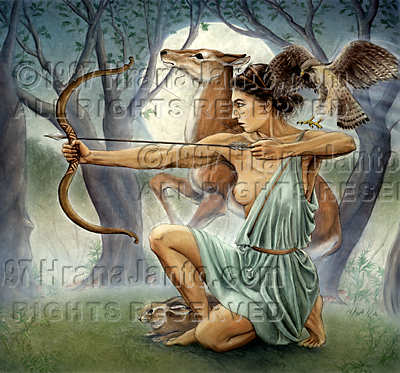 |
|
|||||||
PREVIOUS | NEXT | A,B,C, D,E, F,G,H,I, J,K,L,M, N,O,P,Q, R,S, T,U,V,W,X,Y,Z | Help | ALL | INDEX
| Artemis from Goddesses and Heroines |
Exerpt from Goddess & Heroines by Patricia
Monaghan [Used by permission. This text is NOT included in the Goddess Oracle] |
As we see her in Western art, Artemis is the virginal moon goddess roaming the forest with her band of nymphs, bearing the bow and quiver, avoiding men and killing any male who looks on her. But this familiar form was only one of the identities assumed by this complex Greek goddess, for she was also the many-breasted Artemis of Ephesus, a semi-human symbol of fecundity, and the warlike Artemis said to have been the special goddess of the Amazons.
It is problematical whether Artemis was originally an all-encompassing goddess later divided into separate identities, or if Artemis became so complex by assuming the attributes of lesser goddesses as her worshipers took control of Greece. But, like Isis or Ishtar, Artemis came to represent the variable energies of the feminine. She was therefore contradictory: she was the virgin who promoted promiscuity; she was the huntress who protected animals; she was a tree, a bear, the moon. Artemis was the image of a woman moving through her life and assuming different roles at different times; she was a veritable encyclopedia of feminine possibility.
In one form she was a nymph and ruler of all nymphs, an elemental force whose domain was the greenwood. There an order exists so unlike human order that it seems to us formless and free, but this freedom is that of complete obedience to instinct, which animals still follow while humans do not. Artemis in this form was the "Lady of the Beasts," the force who assured their individual deaths and the survival of the species. As mistress of the animals, she was the invisible game warden of the Greeks, killing with sharp arrows anyone who hunted pregnant beasts or their young. Again as instinct, she ruled reproduction, both sex and birth. She ruled the childbed; even in late legend, when her dominance was undercut by male gods, Artemis was said to have been the elder twin of the sun (not originally her brother) and midwife at Apollo's birth. It was to Artemis, the force of creation, that Greek mothers called when the pangs of birth began, and they found comfort in their belief that she nursed them through labor just as she did any of her other animals.
As the nymph of the greenwood, then, she is not really different from her other most famous form: Mother Artemis, whose vast rich temple at Amazonian Ephesus was one of the wonders of the ancient world. There her massive statue stood, rising from a legless base into a huge torso ringed with breasts, then up to a head surmounted by the turret crown of her city. This Artemis was merely a different visualization of the same energy represented by the woodland nymph: the instinct to live, to produce and reproduce constantly, to devour, and to die. There is power in the image of Ephesia--as Artemis in this form was sometimes called--a power that could be seen as terrifying, so vast and inhuman is it.
The most beloved goddess of Greece, Artemis was honored in rituals that were
wildly popular although as varied as the forms of the goddess herself. At Ephesus,
in her well-endowed temple, Artemis was served by chaste priestesses called
Mellisai, or "bees," and by eunuch priests. In Sparta she was Korythalia, worshiped
in orgiastic dancing. The Amazons honored the war mother Astateia, the mother
as protector of her children, in a circle dance amid the clashing of shields
and swords and the stomping of battle-clad feet. But apparently the most popular
festivals of Artemis were those celebrated on nights of the full moon, when
worshipers would gather in the goddess's wood and give themselves over to her
power in revels and anonymous matings. The beloved goddess of Greece was the
personification of natural law, so different from the laws of society, so much
more ancient, so everlasting.
| Back to TOP | Published by Llewellyn, copyright 1997. Used by permission of the author. |
![]()